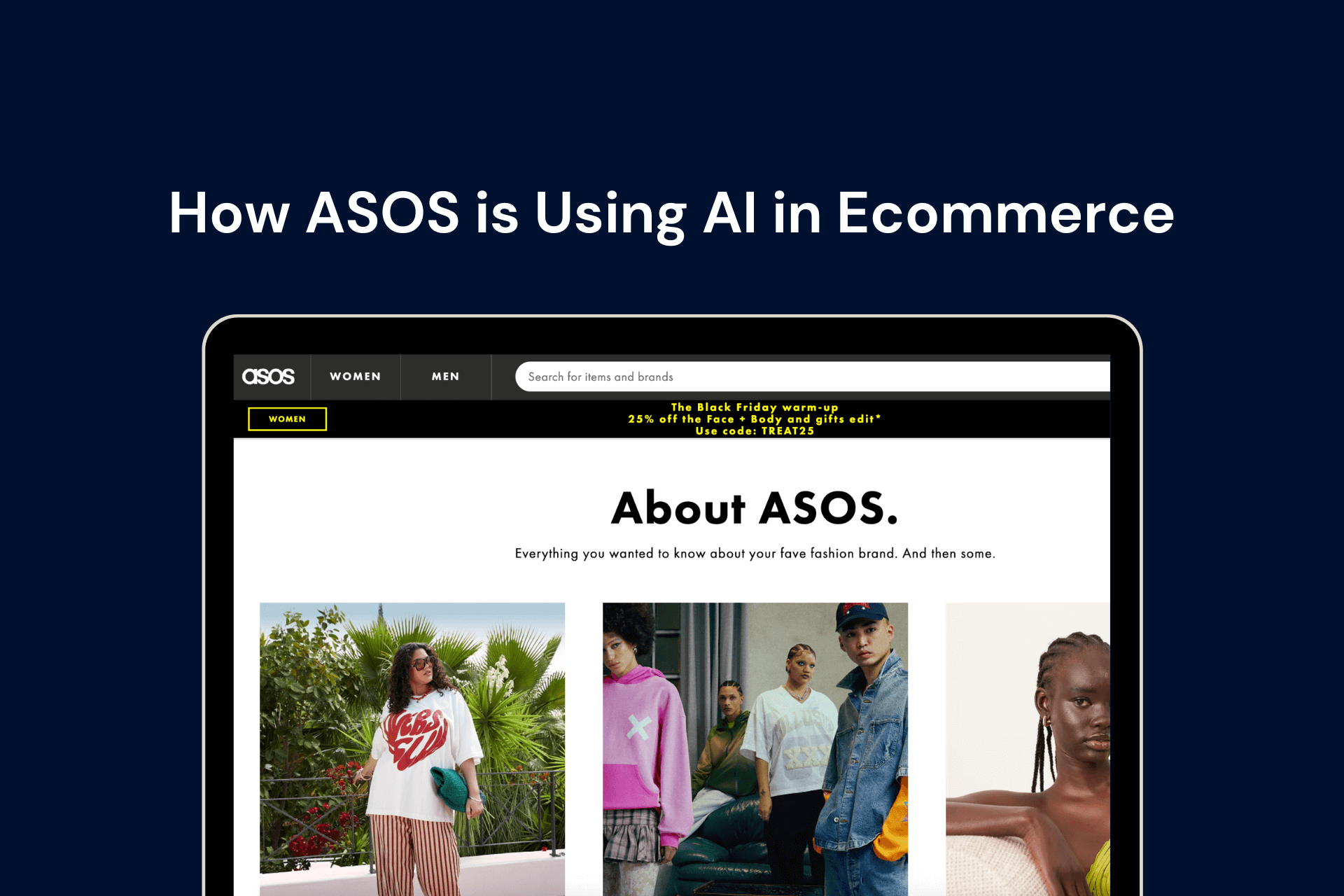Shopify Plus brands are redefining eCommerce with AI-powered merchandising - blending automation, data, and smart strategy to deliver personalized shopping experiences that boost conversions. Discover how to use Shopify’s AI tools and expert merchandising techniques to optimize your store performance and scale smarter.
The success of eCommerce stores depends on how easily and effectively shoppers are able to discover products that match their preferences while shopping in the store.
Because when shoppers can’t find what they’re looking for, they simply abandon and leave the store.
Ecommerce merchants often rely only on rules-based search. For instance, they set rules of how products come on on search based on sales patterns, stock availability, and profit margins.
But rules alone aren’t enough to keep shoppers satisfied and engaged.
That’s why you need AI-driven merchandising, which combines rules and relevance to provide the best results.
In this blog, we explore Shopify AI merchandising and how to implement it in your store to take your growth to the next level.
Let’s get started!
Shopify Plus AI Merchandising in a Nutshell
-
Rules-based search merchandising remains rigid, one-size-fits-all product rankings that do not meet individual shopper needs.
-
Shopify AI merchandising provides an effective solution by combining business rules with machine learning to dynamically rank products.
-
Shopify Plus AI tools and business rules combined re-rank products for each shopper session based on their browsing patterns and purchase intent.
-
Shoppers find products that match their expectations in the first few results. This reduces friction, accelerates conversions.
-
AI provides recommendations on Shopify stores suggesting complementary products based on content and relevance.
-
Better control via AI merchandising leads to more visibility, higher click-through rates, increased average order value, and lower bounce rates.
-
Shopify and Shopify Plus merchants can use native Search and Discovery apps to combine business rules and AI-driven ranking.
-
Shopify AI agencies can help brands with creating strategies, implementing strategies, AI integration, performance monitoring, and more.
Why do Shopify Stores Struggle with Search and Merchandising?
Even though search is a critical factor, most merchants ignore it. Here’s why Shopify merchants struggle with search and merchandising.
Rules-based ranking is rigid
Many Shopify stores set up search systems that prioritize bestsellers, highest margins, or newly launched products. This creates a one-size-fits-all approach. But what works for one customer might not work for others.
Also, customers' preferences keep changing. Hence, with this rigid system, customers might never find the products they’re looking for.
Irrelevant search results lead to abandonment
Shoppers are impatient. If search results do not match their preference, they simply leave the site. This not only lowers your conversion rates, it also builds a negative brand perception. Shoppers assume that you do not have the kinds of products they need. And thus, you might lose customers forever.
Seasonal and trend-driven products get buried
Rules-based search systems are not flexible. For instance, certain products are more in demand in specific seasons, but the systems do not have the intelligence to show products based on seasonal needs. Merchants have to adjust rules with seasonal changes, which often gets missed out.
Personalization gap
Many searches are unique, looking for specific things. But rigid search engines treat all searches the same. Without personalization, customer needs do not get met. This leads to low conversion rates.

What is Shopify AI Merchandising?
AI merchandising uses machine learning models to provide search results. AI merchandising does not rely only on predefined business rules. It looks at shopper behavior, search context, and product performance to dynamically rank results in real time.
Shopify AI merchandising integrated AI in the process, learning from customer interactions, such as clicks, add-to-cart events, purchases, etc. It continuously improves relevance scores.
While traditional merchandising relies on merchants manually setting rules, AI merchandising uses ML and data to continuously evolve how it shows products. Here are some things AI merchandising does:
-
Shows hero products at the top
-
Give visibility to campaign products
-
Show products that maintain minimum margins
-
Dynamically rank results based on shopper behavior and context
How does AI Ranking Transform eCommerce Product Discovery?
AI ranking systems work differently and are more advanced than rules-based systems. Here’s how AI ranking changes eCommerce product discoverability.
1. Real-time signals power AI re-ranking
Shopify AI merchandising systems collect signals across thousands of search sessions. It tracks signals such as clicks on search results, time spent viewing products, add-to-cart conversions, and purchases, etc. Once signals are aggregated, they’re used to build relevance models.
For example, when a new shopper makes a search, the AI model assesses how other such shoppers interacted with products, which products were bought, etc. and how this data can influence the current shopper.
2. Products are re-ranked for each user session
One of the biggest things that differentiates AI from traditional systems is that it re-ranks for each user session. While traditional systems show products in the same order, AI merchandising models show products based on individual shopper context.
For example, if shoppers are searching for “umbrellas”, AI shows different umbrellas to different shoppers. To new shoppers, it will show trending products first, to returning customers it might show complementary products, and to mobile users, it will show fast-shipping products.
3. Faster product discovery accelerates conversion
AI merchandising leads to faster product discoverability and conversion. As the relevance of products is high, shoppers find suitable products within the first few results. They do not have to dig through hundreds of products.
This leads to less frustrated customers, more satisfaction, lesser browsing time, and quick purchases. This has a psychological effect on customers. They feel your brand understands them. This builds trust and increases AOV.
What Role Do Recommendations Play in Shopify AI Merchandising?
Search and recommendations together can enhance customer experience. Here’s more about the role recommendations play in AI merchandising:

1. Recommendations extend the merchandising mix beyond search
While search provides products directly related to what customers want, AI Shopify recommendations offer cross-selling and complementing products. Ecommerce brands can show recommendations on various pages - product pages, cart pages, post-purchase emails, and collection pages. Recommendations are based on purchase history, browsing behavior, among other data.
2. Contextual recommendations outperform static suggestions
A generic recommendation, such as ‘Frequently bought together’ shows the same product to every shopper. AI-based recommendations show products based on context. For instance, a customer buying a coffee machine might be interested in buying coffee mugs and coffee filters. Moreover, AI also considers other factors, such as season, inventory, margins, etc.
3. Common recommendation strategies
Here are some AI-powered product recommendation strategies for eCommerce stores:
-
Frequently bought together based on products purchased in the same order
-
Similar styles based on what shoppers are viewing
-
Complete the look to offer complementing products
-
Customers also viewed based on what similar shoppers viewed
-
New arrivals in this category based on trends
Why is Blending Rules and AI Important?
It’s important to have both control and flexibility and that’s where rules and AI merchandising come together. Here are the benefits of blending the two:
1. Rules provide guardrails
Rules ensure products that need to be focused on are prioritized in the search engine. For instance:
-
New collections that need visibility
-
Products that offer better margins
-
High-profits products
-
Products that need to be cleared from the inventory
-
Seasonal collections
2. AI ensures search doesn’t become rigid
AI adds context and relevance to search. With only rules, the system shows the same products to every shopper. Here are some instances:
-
A rule might state ‘always show new products in the top three results’. AI determines which of these new products should appear first depending on individual shoppers’ preferences
-
A rule might state ‘don’t show products below 50% margin’. AI re-ranks products based on conversion probability
3. Practical use cases illustrate the balance
By adding AI to rules, you can increase practical applications. For instance, if the rule states new season products appear in the first search results, AI product discovery can help determine which specific products appear first for each individual shopper.
How can Shopify Plus Brands Implement AI Merchandising?
Follow these steps and tips to implement AI merchandising in your Shopify Plus store:
1. Use Shopify Plus native tools
Shopify Plus has Shopify Search and Discovery apps integrated into the platform. This provides access to AI-based search and recommendation capabilities. These apps use ML models on search queries. This enables Shopify merchants to configure business rules as well as AI-driven product ranking within a single interface. Shopify Plus makes this capability accessible without requiring deep technical expertise.
2. Configure business rules + AI ranking in eCommerce
Set up rules through the interface. For instance, which products should be promoted, which should be suppressed, collections to highlight, and how margins should be considered, etc. Alongside, AI settings can be set up for which signals should AI consider, for example, purchases, clicks, what level of personalization, and which performance metrics should it optimize.
3. Custom APIs for advanced eCommerce personalization
Some Shopify Plus stores may have more sophisticated needs, requiring deeper personalization. Integrate custom APIs that integrate with proprietary ranking models, customer data platforms, and business intelligence systems. For instance, create models such as real-time inventory levels, campaign calendars, CLV, etc.
4. Shopify agencies to balance AI with business goals
Hiring expert Shopify AI agencies and retainers can help with strategic implementation of business rules along with AI. XgenTech, a Shopify agency can help your brand navigate complexities of combining automation with business goals, and understand both technical AI systems and business priorities. The agency can also determine which rules are essential, and how to measure success. Agencies also help manage optimization, testing different rule configurations, and adjust strategies.
What Results Can AI Merchandising Deliver?
Here are the key performance indicators on which AI merchandising has an impact:
1. Click-through rate improvement
Shifting from rule-based systems to AI-powered search drives increased click-through rates because search results are more relevant, products match shopper intent, and ranking order is based on relevance. Higher click-through rates means more opportunities for brands to drive conversions. Besides, more data for AI systems to capture.
2. Average order value increase
Shopify AI merchandising has the ability to identify products that drive higher AOV and feature them prominently. It recommends complimentary products on the cart page. AI systems strategically place these high AOV products and recommendations, leading to higher AOV.
3. Drop in bounce rate
When search results are relevant, visitors tend to click, explore the products, and make purchases. This reduces bounce rates. Lower bounce rates means more shoppers proceed further in the shopping journey, and more opportunities for brands to upsell and cross-sell.

Shopify AI Merchandising Mistakes to Avoid
-
Some merchants are uncomfortable with AI and hence create too many rules. Over-relying on rules can have a negative impact on eCommerce personalization.
-
Over-relying on AI can take away control from you. For example, this can lead to seasonal inventory getting buried because the AI system isn’t showing those products when the season changes.
-
AI merchandising is not a one time activity. It needs to be tracked and optimized based on performance. Hence, A/B testing and consistent monitoring is essential.
-
Many merchants focus on the website, ignoring mobile experiences, even though most traffic comes from mobile. AI merchandising that is not optimized for mobile, misses out on a significant amount of conversion opportunities.
What to Look for in a Partner for Shopify AI Merchandising?
-
Assess the Shopify AI merchandising agency’s expertise with implementing Shopify Plus AI tools, catalog handling capabilities, technical integration knowledge, etc.
-
Request potential partners to share case studies and references from past projects that have similar complexity and traffic patterns.
-
Partners that understand that business rules matter as much as AI merchandising. Efficient partners know how to balance rules and AI.
-
AI partners that have technical integration skills and implementation knowledge.
-
Partners who provide transparent reporting and ROI demonstration.
Wrapping up
Only rules-based search limits results. Including Shopify AI merchandising provides balance of control and personalization. When business rules and relevance come together, the product discoverability increases, customers get a better shopping experience, and conversions increase.
Brands can work with AI partners and agencies to implement Shopify Plus AI tools, build strategies, track performance, and continuously optimize business rules and AI merchandising strategies.
If you want to implement a rules and AI merchandising strategy in your Shopify Plus store, partner with XgenTech.
Frequently Asked Questions About Shopify Plus AI Merchandising
1. What is Shopify AI merchandising?
Shopify AI merchandising uses artificial intelligence to personalize product rankings, collections, and recommendations based on shopper behavior, preferences, and store data.
2. How does Shopify Plus use AI for merchandising?
Shopify Plus integrates AI through tools like Shopify Search & Discovery, enabling automatic product sorting, predictive search, and tailored product suggestions that increase conversions.
3. What are business rules in AI merchandising?
Business rules set manual conditions - like promoting high-margin items or excluding out-of-stock products - so AI decisions align with brand strategy and inventory goals.
4. Can I combine business rules and AI on Shopify?
Yes. You can blend custom rules with Shopify’s AI to balance automation and control - letting machine learning optimize results while you set key merchandising priorities.
5. What are the benefits of AI merchandising for Shopify stores?
AI merchandising improves search accuracy, boosts average order value (AOV), and enhances customer experience through data-driven, personalized product discovery.
6. Which Shopify apps support AI-powered merchandising?
Apps like Shopify Search & Discovery, LimeSpot, Nosto, and Rebuy help implement AI-driven personalization and smart product recommendations.
7. How can I measure the impact of AI merchandising?
Track metrics like click-through rate (CTR), conversion rate, AOV, and revenue per session to evaluate how AI-driven merchandising affects store performance.
8. Does AI merchandising work for small stores too?
Yes. Even smaller Shopify stores can use AI merchandising tools to boost engagement and automate personalized experiences with minimal setup.




